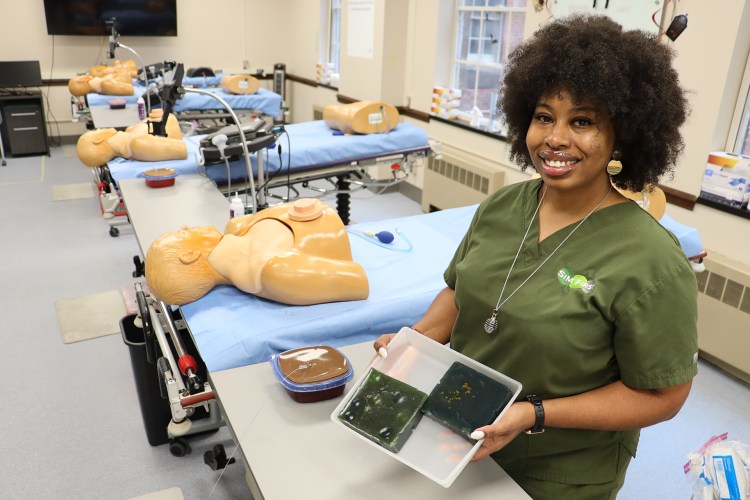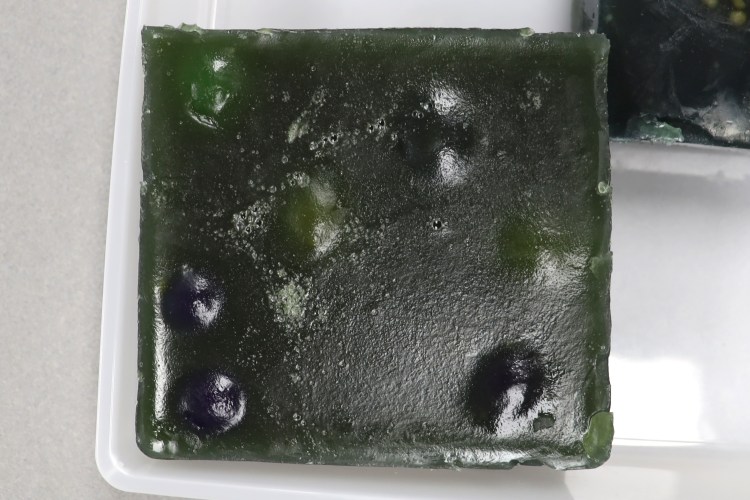Masters of Their Craft: Procedural sim program creates tailormade trainers

There’s always room for Jell-O — especially in procedural simulation.
When UAB Clinical Simulation’s Ca’Nesia Jackson thought to combine gelatin with water beads, the result wasn’t edible, but instead educational.
It’s one of many examples that embodies the procedural simulation program’s inventive nature. Jackson, a clinical simulation equipment technician, shares that affinity for craftiness.
“I love being able to express my quirkier side,” she said. “I’ve always been a mini tech nerd, fidgeting with things and figuring out how they work. When I was younger, I used to take things apart and put them together again.”
Now, she does a little bit of both, supporting the procedural simulation program through myriad ways, from trainer creation and maintenance to equipment acquisition and inventory management to moulage, e.g., special effects makeup used to replicate injuries, conditions, diseases, etc.
“Every time my mom asks me what I do in my job, I have a new answer, like, ‘I made skin today, Mom,’” Jackson said. “But as a whole, we try to create the highest fidelity simulations possible, so that learners will be able to focus and not be distracted by anything else going on. We also strive to provide a safe environment, so learners can effectively practice a procedure without the risks associated with their actual professional environment.”
The procedural simulation team collaborates with providers and staff in the UAB health system to create simulation-based training that is pertinent to their clinical practice area, whether it’s intended to provide initial exposure to the process of a procedure, to practice rare or risky procedures, or for ongoing maintenance of procedural skills.
Additionally, the team works with those interested in facilitating simulation to help them develop the skills associated with using simulation as a teaching tool.
When there is not a commercially available trainer that provides the experience or feedback that the learners need, the procedural simulation staff flexes their creativity to modify existing trainers or develop new ones. Sometimes, this leads to some out-of-the box ideas.
For instance, while working to develop a portable vascular access trainer, Jackson spotted some water beads a colleague had brought into the fabrication lab. They immediately caught her eye.
“I wondered if they would show up on an ultrasound,” Jackson said. “After that, I went for the gelatin molds and put the water beads inside. Once it settled, I performed an ultrasound on the mold, and the water beads showed up really well.”
The concept seemed promising, as the team had been discussing possibilities for low-cost trainers to practice aspirating fluid from abscesses and cysts with ultrasound guidance.

“When we attempted to aspirate fluid from the water beads, it didn’t work the way we’d hoped it would,” Jackson admitted. “But we were able to draw solid samples from the beads.”
That’s when Director of Procedural Simulation Lisa Bergman proposed the trainer as an option for the first iteration of superficial core biopsy simulation for diagnostic radiology residents, collaboratively developed with and led by Dr. Coz Burgan and Molly Miller, PA-C.
“And it ended up being the perfect trainer for those learners,” Jackson said. “In fact, we plan on using it for that same simulation again.”
Bergman was pleased with the results from a programmatic standpoint, as well.
“The commercially available trainers for this procedure are quite expensive and are not as durable as their price tag would suggest,” she said. “The trainer that Ca’Nesia developed has all of the capabilities of the commercial trainers at a small fraction of the cost, which negates the need for the trainer to be durable. When the sim is done, we can simply dispose of the used trainer and manufacture a new trainer for the next sim for just a few dollars and a small amount of our time.”
All in all, Jackson was elated with the results, even learning something about herself.
“I truly thought the trainer had failed,” she said. “When we put it to another use, and when the instructors said it was exactly what they were looking for, I almost cried. I like that I can be creative and am encouraged to make mistakes, because that’s sometimes the only way to learn. Plus, I’m able express myself in a way I didn’t think I could growing up. I didn’t think I could be a quirkier version of myself.”
Want to Get Involved?
To participate in the procedural simulation process, you can collaborate with UAB Clinical Simulation to create and/or learn to facilitate simulation based procedural training. This program is available to providers and staff in the UAB health system.
For more information about procedural simulation at UAB, please contact us at simulation@uabmc.edu.




0 Comments